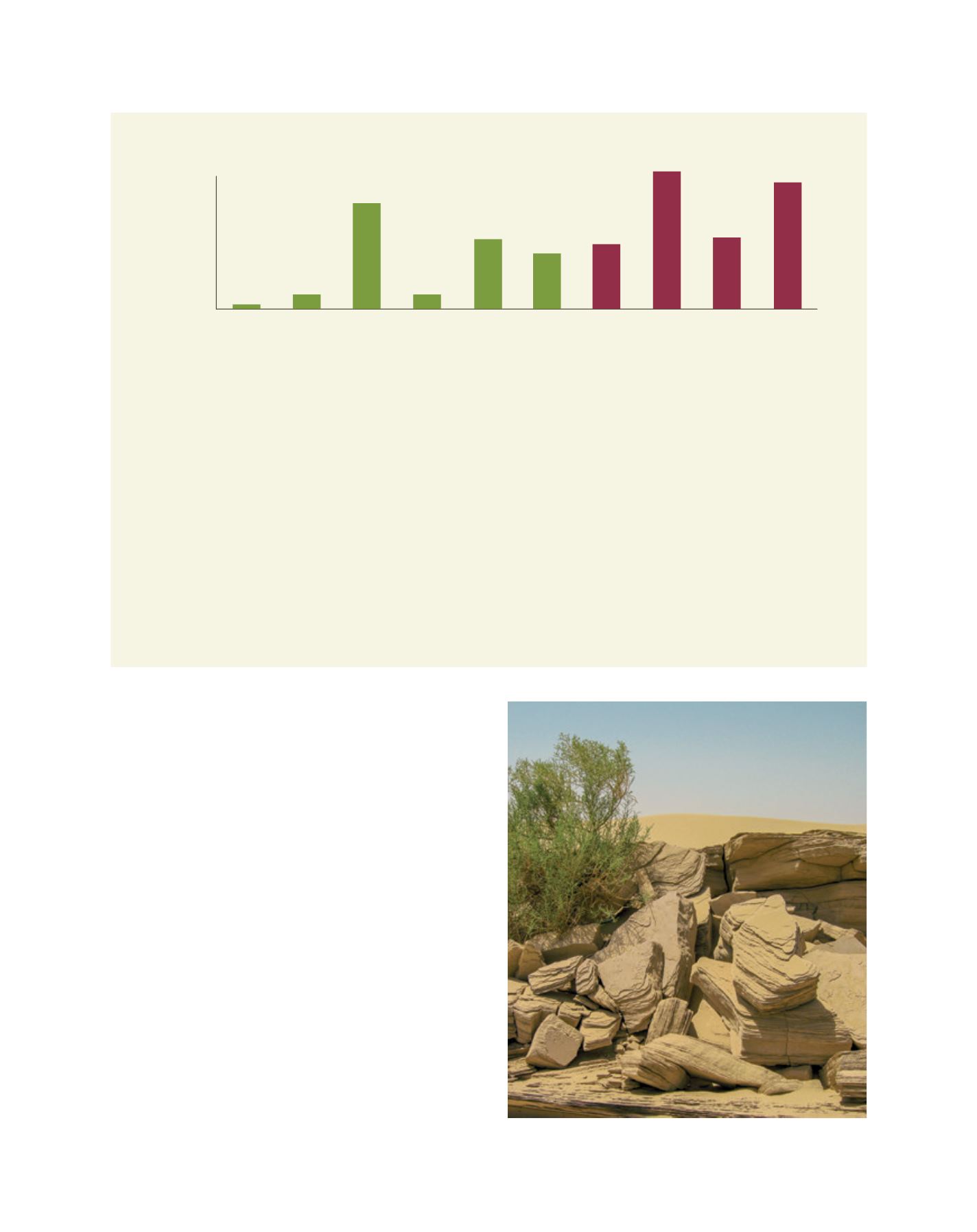

[
] 174
ICBA has vast experience in managing marginal lands
(sandy, salt-affected soils) through scientific and site-specific
diagnostics. The marginality has been mainly in two forms:
desert sandy soils and salt-affected lands. The former is
confined to desert environments where loose sand forms
the major landscape and basis for agricultural farms.
6
The
salt-affected lands can be found both on sandy deserts and
other arid region soils of various soil textures. ICBA scien-
tists believe that it may be possible to keep the soils healthy
and productive for a long time when a soil health programme
goes simultaneously with agricultural activities.
Sandy desert soils (hot arid climate) are plagued with
very low water and nutrient holding capacities, which
results in frequent irrigation and nutrient application,
high leaching and nutrient losses. Such harsh conditions
call for new ways to conserve water, improve soil proper-
ties and prevent nutrient losses. One of the best ways is to
modify sandy soils with organic and inorganic amendments
to improve soil tilth and ultimately improve moisture
and nutrient retention, leading to efficient use of water
resources and preventing groundwater pollution. At ICBA
we have proved through greenhouse and field trials that
the addition of suitable quantities of organic and inorganic
amendments improved soil qualities, leading to significant
water saving and doubling fresh biomass production.
Integrated plant nutrient management for sandy soil
One of the best ways to improve soil properties and prevent nutrient
losses is to improve soil health through innovative ways using organic
amendments and minimizing the use of fertilizers. In order to achieve this
we have conducted a greenhouse experiment to test the integrated effects
of chemical fertilizer (CF), compost (C), biofertilizer (BF) and biochar (BC) on
maize crop productivity and improvements in nutrient availability.
A pot experiment was conducted in the greenhouse using the following
treatments with three replication:
T1 — Control
T2 — Compost @ 5 tons/ha
T3 — Compost @ 5 tons/ha + 100 per cent conventional fertilizer
T4 — Compost @ 5 tons/ha + 5.5 L/ha biofertilizer
T5 — Compost @ 5 tons/ha + 50 per cent fertilizer + 5.5 L/ha
biofertilizer
T6 — Compost @ 5 tons/ha + 25 per cent fertilizer + 5.5 L/ha
biofertilizer
T7 — Compost @ 5 tons/ha + 5 tons biochar/ha
T8 — Compost @ 5 tons/ha + 100 per cent conventional fertilizer
+ 5 tons biochar/ha
T9 — Compost @ 5 tons/ha + 5.5 L/ha biofertilizer + 5 tons Biochar/ha
T10 — Compost @ 5 tons/ha + 50 per cent fertilizer + 5.5 L/ha
biofertilizer + 5 tons biochar/ha.
The results are presented as grams per pot (each pot contains 10
plants). They show that agricultural intensification in desert sandy soils
can be achieved through appropriate combinations of organic and
inorganic soil amendments
General observations revealed the maximum biomass production
was found when biochar was applied in combination with 100 per cent
conventional fertilizer (T8), which is 29 per cent more compared to where
chemical fertilizer was applied alone (T3). All treatment combinations
increased fresh biomass over the control treatment (T1) in various
ranges. It was also found that when half of the chemical fertilizer was
applied in combination with biofertilizer and biochar (T10), an increase of
19.7 per cent fresh biomass was recorded compared to where 100 per
cent conventional fertilizer was applied (T3). The application of various
amendments has increased cation-exchange-capacity (9-15 per cent) and
organic carbon (48-52 per cent) compared to T3.
Source: ICBA
0
T1
T2
T3
T4
T5
T6
T7
T8
T9
T10
200
400
600
Fresh biomass (gm/pot)
(10 plants/pot)
800
Desert soils are loose and fragile — a view of degraded land in UAE deserts
Image: ICBA
L
iving
L
and
















